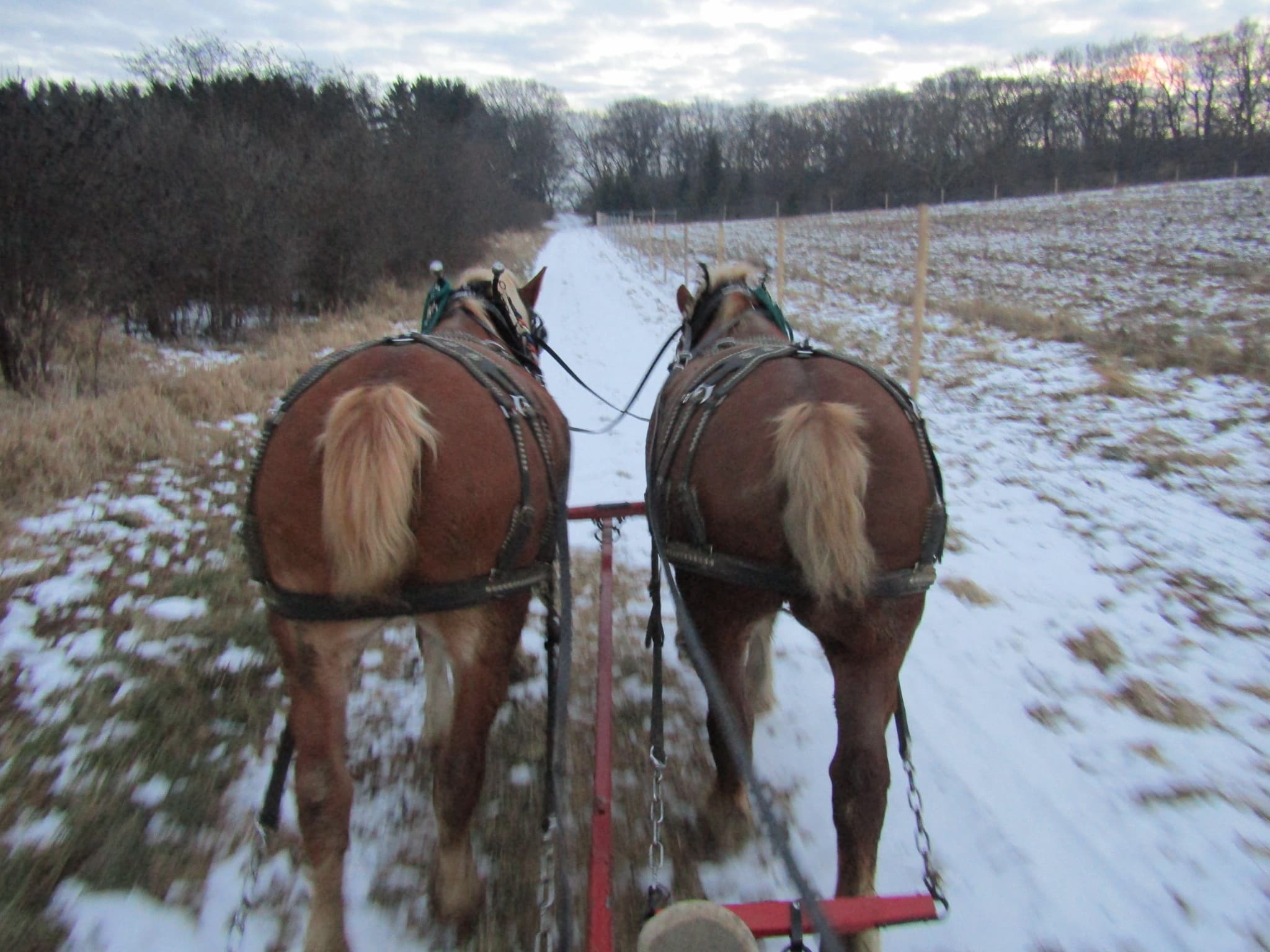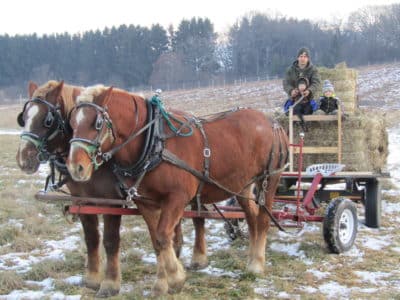
by Ryan Heinen, Land and Livestock Manager | The last time a team of draft horses worked this land was 1958. That’s the year that the Williams family built the new dairy barn. Lloyd Williams told me that this new barn did not include stalls for horses, and so the team was sold. My grandfather had a dairy farm and used an F-12 Farmall tractor and a team of Percheron draft horses named Ginger and Bert. The team was also sold around 1960 and was replaced by an H-Farmall tractor. Tractors rapidly replaced draft horses across American farms following World War II, so much that the top five breeds became dangerously low in number.
Introducing Pete and Pearl
 Pete and Pearl are Gwenyn Hill’s team of Belgian draft horses, and for the first time in 60 years, this farm will again be using real horsepower. Pete is an 11-year old gelding and Pearl is a 13-year old mare. They stand about 5 ½ feet tall at the shoulder and each weigh around 1800 pounds. The team’s main job this winter will be pulling hay out to feed the cattle, skidding logs out of the woods, plowing snow, and spreading manure.
Pete and Pearl are Gwenyn Hill’s team of Belgian draft horses, and for the first time in 60 years, this farm will again be using real horsepower. Pete is an 11-year old gelding and Pearl is a 13-year old mare. They stand about 5 ½ feet tall at the shoulder and each weigh around 1800 pounds. The team’s main job this winter will be pulling hay out to feed the cattle, skidding logs out of the woods, plowing snow, and spreading manure.
A mixed horse and tractor-powered farm has many benefits and can be more economical. While some jobs such as plowing large fields or baling hay are best for tractors, smaller jobs such as planting mid-season cover crops, raking hay, feeding cattle, or working in the woods can be done with horses. Horses don’t compact the land like a tractor, they always start in the winter, and mechanical breakdowns (injuries and sore muscles) usually repair themselves with time and good care. They run on farm-grown fuel. Unlike polluting diesel tractor exhaust, the horse actually improves the land with its exhaust (manure). A good team of horses can disc ten acres per day or rake sixteen acres of hay. They can plant ten acres of oats or mow eight acres of hay.
Video: Pete & Pearl
Putting the Horses Before the Cart
If you come by the farm this winter, you may see me out working with the horses using what is called a forecart. It’s a handy cart that allows me to hook up and pull hay wagons, logs, hay bales, or many ground-driven tractor implements. I have even used it to pull a stuck tractor and truck out of the mud!
Of course, horses are not machines, and don’t always do exactly what I want. Like people, they can have a bad day or be temperamental. They also can’t work for hours on end without a break, but I truly enjoy working with them. I like the sound of the harness chains clinking as we work, seeing the horses learn the job, and anticipating the turn at the end of a row when cultivating or cutting hay. I even like the smell of warm horses and sweaty harness leather. There is something very rewarding about working with these powerful animals, being part of a human and animal team. While it might seem old-fashioned to work with draft horses, I believe that new technology should not always replace traditional skills, tools and knowledge. Rather, a blending of the new with the old is likely to produce the best results.
My dad remembers at the age of seven, riding on the wagon pulled by their team of horses, my grandpa walking along as they picked up bundles of corn stalks, headed to the silo to chop into silage. He remembers thinking that he was driving these huge horses, although my grandpa’s voice saying “whoa” to stop and “step up” to go likely controlled the team. I am glad to know that as my own young boys work with me they will someday look back with a similar memory.
